I have information on groups of physicians working together in given hospitals. A physician can work in more than one hospital at the same time. I would like to write a code that outputs information of all indirect colleagues of a given physician working in a given hospital. For instance, if I work in a given hospital with another physician who also works in another hospital, I would like to know who are the physicians with whom my colleague works in this other hospital.
Consider a simple example of three hospitals (1, 2, 3) and five physicians (A, B, C, D, E). Physicians A, B and C work together in hospital 1. Physicians A, B and D work together in hospital 2. Physicians B and E work together in hospital 3.
For each physician working in a given hospital I would like information of their indirect colleagues through each of their direct colleagues. For example, physician A has one indirect colleague through physician B in hospital 1: this is physician E in hospital 3. On the other hand, physician B does not have any indirect colleague through physician A in hospital 1. Physician C has two indirect colleagues through physician B in hospital 1: they are physician D in hospital 2 and physician E in hospital 3. And so on..
Below is the object that describes the nertworks of physicians in all hospitals:
edges <- tibble(hosp = c("1", "1", "1", "1", "1", "1", "2", "2", "2", "2", "2", "2", "3", "3"),
from = c("A", "A", "B", "B", "C", "C", "A", "A", "B", "B", "D", "D", "B", "E"),
to = c("C", "B", "C", "A", "B", "A", "D", "B", "A", "D", "A", "B", "E", "B")) %>% arrange(hosp, from, to)
I would like a code that produces the following output:
output <- tibble(hosp = c("1", "1", "1", "1", "1", "1", "1", "2", "2", "2", "2", "2", "2", "2", "3", "3", "3", "3", "3"),
from = c("A", "A", "B", "B", "C", "C", "C", "A", "A", "B", "B", "D", "D", "D", "B", "E", "E", "E", "E"),
to = c("C", "B", "C", "A", "B", "A", "B", "D", "B", "A", "D", "A", "B", "B", "E", "B", "B", "B", "B"),
hosp_ind = c("" , "3", "" , "" , "2", "2", "3", "" , "3", "" , "" , "1", "1", "3", "" , "1", "1", "2", "2"),
to_ind = c("" , "E", "" , "" , "D", "D", "E", "" , "E", "" , "" , "C", "C", "E", "" , "A", "C", "A", "D")) %>% arrange(hosp, from, to)
